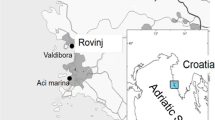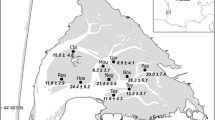Abstract
There are many reported associations between mussels and other invertebrates, such as pea crabs, polychaetes, turbellarians and copepods, which live in their mantle cavities. The boundary between commensalism and parasitism is often indistinguishable because of insufficient knowledge or because the interaction is variable. Preliminary evidence led to a closer examination of the relationship between the mussel, Mytilus edulis platensis, and an isopod, Edotia doellojuradoi, previously described as commensalism. Monthly intertidal samples of mussels were taken from September 2004 to August 2005 at Caleta Cordova Norte (45°43′S, 67°22′W) in southern Argentina and assessed for the prevalence and abundance levels of isopods. Mussels with and without isopods were measured, examined for evidence of gill damage and their condition (soft tissue dry weight) was determined. The overall isopod prevalence in mussels was 57.9% and infestation varied with mussel length, with maximum occurence at 30.2 mm (medium-sized mussels). Experimental evidence indicated that the position of the isopod inside the mussel depended on the feeding activity of the mussel. Female isopods were observed grasping the ventral food groove of the gill demibranchs and feeding on the mucous food strand produced by the mussel. Juveniles and males were observed clustered together on the dorsal side of the single female in each occupied mussel, suggesting extended maternal care. Gill damage was observed in 58.2% of mussels at the Argentine site and was significantly associated with isopod occurrence. Categorical regression analysis showed that the most important factor associated with the degree of gill lesions was the number of male and juvenile isopods per mussel, followed by the length of female isopods and the developmental stage of juveniles. Conversely, the degree of gill damage decreased with increasing mussel length. Overall, E. doellojuradoi had a significant effect on mussel condition throughout the year, with low flesh weight in mussels with isopods, except during the austral summer and early autumn. In contrast to previous studies, which concluded that the isopod was a commensal, the present study clearly demonstrates that E. doellojuradoi is a parasite of M. edulis platensis. Other symbiotic interactions formerly classified as commensal might not be innocuous on further investigation, especially if samples are taken at multiple sites and at different times of the year.







Similar content being viewed by others
References
Agresti A (1990) Categorical data analysis. Wiley-Interscience, New York
Atkins D (1931) Note on the regeneration of the gill of Mytilus edulis. J Mar Biol Assoc UK 17:551–566
Begon M, Townsend CR, Harper JL (2006) Ecology: from individuals to ecosystem. Blackwell, London
Bierbaum R, Shumway SE (1988) Filtration and oxygen consumption in mussels, Mytilus edulis, with and without pea crabs, Pinnotheres maculatus. Estuaries 11:264–271. doi:10.2307/1352013
Bower SM (1992) Diseases and parasites of mussels. In: Gosling E (ed) The mussel Mytilus: ecology, genetics and culture. Elsevier, Amsterdam, pp 543–563
Brandt A, Bruce N (2006) Edotia tangaroa sp. nov. (Crustacea: Isopoda: Idoteidae) from the western Ross Sea, Antarctica. Zootaxa 1313:57–68
Britayev TA, Martin D, Krylova EM, von Cosel R, Askiuk TS (2007) Life-history traits of the symbiotic scale-worm Branchipolynoe seepensis and its relationships with host mussels of the genus Bathymodiolus from hydrothermal vents. Mar Ecol 28:36–48. doi:10.1111/j.1439-0485.2007.00152.x
Foster-Smith RL (1975) The effect of concentration of suspension on the filtration rates and pseudofaecal production for Mytilus edulis L., Cerastoderma edule (L.) and Venerupis pullastra (Montagu). J Exp Mar Biol Ecol 17:1–22. doi:10.1016/0022-0981(75)90075-1
Giambiagi D (1925) Resultados de la primera expedición a Tierra del Fuego (1921). Enviada por la Facultad de Ciencias Exactas, Físicas y Naturales de la Universidad Nacional de Buenos Aires. Crustáceos Isópodos. Anales de la Sociedad Científica Argentina, pp 229–246
Goeter CL, Weber AE (1996) Factors affecting the distribution and abundance of Mytilicola orientalis (Copepoda) in the mussel Mytilus trossulus in Barkley Sound, B.C. J Shellfish Res 15:861–864
González M, Jaramillo E (1991) The association between Mulinia edulis (Mollusca, Bivalvia) and Edotea magellanica (Crustacea, Isopoda) in southern Chile. Rev Chil Hist Nat 64:37–51
Gosling EM (1992) Genetics of Mytilus. In: Gosling E (ed) The mussel Mytilus: ecology, physiology, genetics and culture. Elsevier, Amsterdam, pp 309–382
Gray AP, Seed R, Richardson CA (1997a) Reproduction and growth of Mytilus edulis chilensis from the Falkland Islands. Sci Mar 61:39–48
Gray AP, Richardson CA, Seed R (1997b) Ecological relationships between the valviferan isopod Edotia doellojuradoi Giambiagi, 1925, and its host Mytilus edulis chilensis in the Falkland Islands. Estuar Coast Shelf Sci 44:231–239. doi:10.1006/ecss.1996.9999
Grove MW, Finelli CM, Wethey DS, Woodin SA (2000) The effects of symbiotic crabs on the pumping activity and growth rates of Chaetopterus variopedatus. J Exp Mar Biol Ecol 246:31–52. doi:10.1016/S0022-0981(99)00171-9
Higgins LE, Buskirk RE (1998) Spider-web kleptoparasites as a model for studying producer–consumer interactions. Behav Ecol 9:384–387
Hilbish TJ, Mullinax A, Dolven SI, Meyer A, Koehn RK, Rawson PD (2000) Origin of the antitropical distribution pattern in marine mussels (Mytilus spp.): routes and timing of transequatorial migration. Mar Biol 136:69–77. doi:10.1007/s002270050010
Hopkins SH (1957) Interrelations of organisms. B. Parasitism. In: Hedgpeth JW (ed) Treatise of marine ecology and paleoecology, ecology, vol 1. Mem Geol Soc Am, pp 413–428
Iyengar EV (2008) Kleptoparasitic interaction throughout the animal kingdom and a re-evaluation, based on participant mobility, of the conditions promoting the evolution of kleptoparasitism. Biol J Linn Soc 93:745–762. doi:10.1111/j.1095-8312
Jaramillo E, Navarro J, Winter J (1981) The association between Mytilus chilensis Hupe (Bivalvia, Mytilidae) and Edotea magellanica Cunningham (Isopoda, Valvifera) in southern Chile. Biol Bull 160:107–113
Jones HD, Richards OG, Southern TA (1992) Gill dimensions, water pumping rate and body size in the mussel Mytilus edulis L. J Exp Mar Biol Ecol 155:213–237. doi:10.1016/0022-0981(92)90064-H
Lauckner G (1983) Diseases of Mollusca: Bivalvia. In: Kinne O (ed) Diseases of marine animals, vol 11. Biologische Anstalt Helgoland, Hamburg, pp 477–961
Leung TLF, Poulin R (2008) Parasitism, commensalism, and mutualism: exploring the many shades of symbiosis. Vie Milieu 58:107–115
McDonald JH, Seed R, Koehn RK (1991) Allozymes and morphometric characters of three species of Mytilus in the Northern and Southern Hemispheres. Mar Biol 111:323–333. doi:10.1007/BF01319403
Meulman JJ, Heiser WJ (2007) SPSS categories 15.0. SPSS Inc., Chicago
Morton B (1992) The evolution and success of the heteromyarian form in the Mytiloida. In: Gosling E (ed) The mussel Mytilus: ecology, physiology, genetics and culture. Elsevier, Amsterdam, pp 21–52
Petes LE (2007) Effects of environmental stress on intertidal mussel reproduction. PhD Thesis, Oregon State University, Oregon
Poulin R (2007) Evolutionary ecology of parasites. Princeton University Press, New Jersey
Rathbun MJ (1918) The grapsoid crabs of America. Bull US Natn, Mus 97:1–461
Rohde K (1982) Ecology of marine parasites. University of Queensland Press, New York
Sastry AN, Menzel RW (1962) Influence of hosts on the behavior of the commensal crab Pinnotheres maculatus Say. Biol Bull 123:388–395
Sheppard EM (1957) Isopod Crustacea. Part II. Discovery Reports 29:141–198
Sokal RR, Rohlf FJ (1995) Biometry. The principles and practice of statistics in biological research. WH Freeman & Company, New York
Soot-Ryen T (1955) A report on the family Mytilidae. Allan Hancock Pacific Expedition 20:1–154
ter Braak CJF, Looman CWN (1995) Regression. In: Jongman RHG, Ter Braak CJF, Van Tongeren OFR (eds) Data analysis in community and landscape ecology. Cambridge University Press, Cambridge, pp 29–77
Thiel M (2000) Extended parental care behavior in crustaceans—a comparative overview. In: von Vaupel Klein JC, Schram FR (eds) Crustacean issues 12: the biodiversity crisis and Crustacea. CRC Press, Boca Raton, Florida, pp 211–226
Tortorelli MC (1987) Contribución al estudio de los ciclos reproductivos del mejillón patagónico, Mytilus chilensis Hupé, y de la cholga, Aulacomya ater (Molina), en el Canal Beagle. PhD thesis, Universidad Nacional de Buenos Aires, Argentina
Trucco MI (2000) Diferenciación genética con polimorfismos alozimicos de Mytilus spp. del Atlantico Sudoccidental. PhD thesis, Facultad de Ciencias, Universidad de Vigo, Spain
Vinuesa JH (1978) Ciclo gonadal y primera madurez sexual del mejillón patagónico Mytilus edulis chilensis Hupe, de Puerto Deseado. Physis 38:35–47
Ward JE, Shumway SE (2004) Separating the grain from the chaff: particle selection in suspension—and deposit-feeding bivalves. J Exp Mar Biol Ecol 300:83–130. doi:10.1016/j.jembe.2004.03.002
Zaixso HE (1975) Distribución vertical de los moluscos marinos de la ría Deseado (Santa Cruz, Argentina). Sustratos con fracción limosa. Physis 34:229–243
Acknowledgments
The authors sincerely thank Javier A. Tolosano for his help in the field surveys and Alicia Boraso de Zaixso for revision and criticism of the manuscript. Microalgae were kindly provided by Laura Perez and Susana Perales from the Marine Microalgae Culture Collection (Depto. Biol. Gral., FCN, UNPSJB). The performed experiments complied with the current laws of the Republic of Argentina.
Author information
Authors and Affiliations
Corresponding author
Additional information
Communicated by J. P. Grassle.
Electronic supplementary material
Below is the link to the electronic supplementary material.
Rights and permissions
About this article
Cite this article
Zaixso, H.E., Stoyanoff, P. & Gil, D.G. Detrimental effects of the isopod, Edotia doellojuradoi, on gill morphology and host condition of the mussel, Mytilus edulis platensis . Mar Biol 156, 2369–2378 (2009). https://doi.org/10.1007/s00227-009-1265-3
Received:
Accepted:
Published:
Issue Date:
DOI: https://doi.org/10.1007/s00227-009-1265-3




